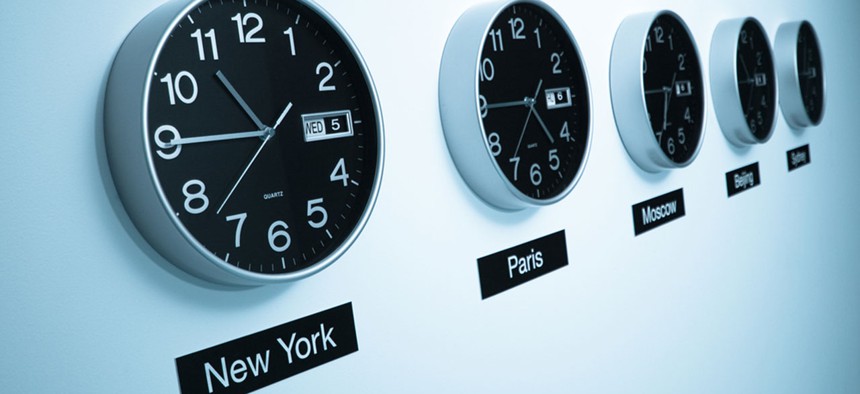
vtwinpixel/Shutterstock.com
How to Win the Hearts and Minds of Colleagues In Distant Time Zones
Take a few extra seconds and do some time zone math so they don't have to.
Today, over 125 years ago, US president Chester A. Arthur called a major global conference to discuss the little matter of time. The US had just ironed out the differences in its railway times—until 1883, American railways had to adhere to dozens of times calculated locally, with some cities just a few minutes apart—and now it wanted to see the same kind of standardization globally.
It took more than a half century—only Japan quickly adopted the Greenwich meridian as a “zero” longitude for calculating its time—but eventually global time standardization was achieved. Despite that dramatic reduction in global confusion, the rise of multinationals and expat workers means we’re coordinating more than ever with people scattered across multiple time zones. Fortunately, it only takes a tiny bit of etiquette to make those dealings go so much better.
Whether I’m calling distant colleagues, or trying to keep up with friends and family, one thing that makes it much easier is offering the other person a time to talk—or better yet, a range of times—converted into their local time.
For many globetrotting workers, this might seem such an obvious thing to do that it shouldn’t need explaining. Yet, more often than I’d expect, people in another time zone, working in jobs with international exposure, have written to me proposing calls without that clarification. Before I can even consider saying yes, I have to ask for more information, or do a time conversion.
Few of us work in offices that have multiple clocks on the wall showing the time in different capitals. But it’s easier than it’s ever been to figure that out. The quickest way is to just Google it, but make sure your search is specific enough—search by city, not by country. Just as the US has multiple time zones, so does Australia—its western city of Perth, for example, is on the same time as Hong Kong, two hours behind capital Canberra to the east. Russia, meanwhile, has 11 time zones. Vast China used to have five, but since 1949, for reasons of national unification, has just one.
If there are places in the world you call repeatedly, add them under the world clock option on your phone (there are also lots of apps for that, such as Klok, recommended by one of my itinerant colleagues). And if you’re roping in a couple of colleagues at once, try a map like this oneor the elegant sliders of this site, both of which show the actual time right now in multiple places.
What does all this mean in terms of what to say when you’re next setting up an international phone call? Instead of this:
“How about 8pm on Tuesday?”
Or even this:
“How about 8pm ET on Tuesday?” (although this is better)
Try this (assuming, for example, you’re in New York and your colleague is in Hong Kong):
“How about 8am your time on Tuesday? That’s 8pm Monday here in New York.”
It might seem like overkill to include the time in your own city as well. But if you have to do this kind of planning often, you are going to make a mistake every now and again. It’ll be easier for one of you to catch it if you list the times in both places.
Even if you happen to know the colleague you’re dealing with has the time differences for a couple of cities down pat, it’s still a nice touch to offer the time conversion, particularly if you’re the one seeking their help. It suggests that you took a few extra seconds of your time, so they wouldn’t have to.
Of course, depending on your profession, there are going to be times you have to quickly call a colleague whose location you’re not sure of. If it’s after lunch for you and you have a vague idea they’re a plane ride of more than a few hours away, chances are you’ll be waking them up. When it’s urgent, rest assured they’ll understand. And never, ever make this your opening line:
“So, what time is it over there anyway?”






